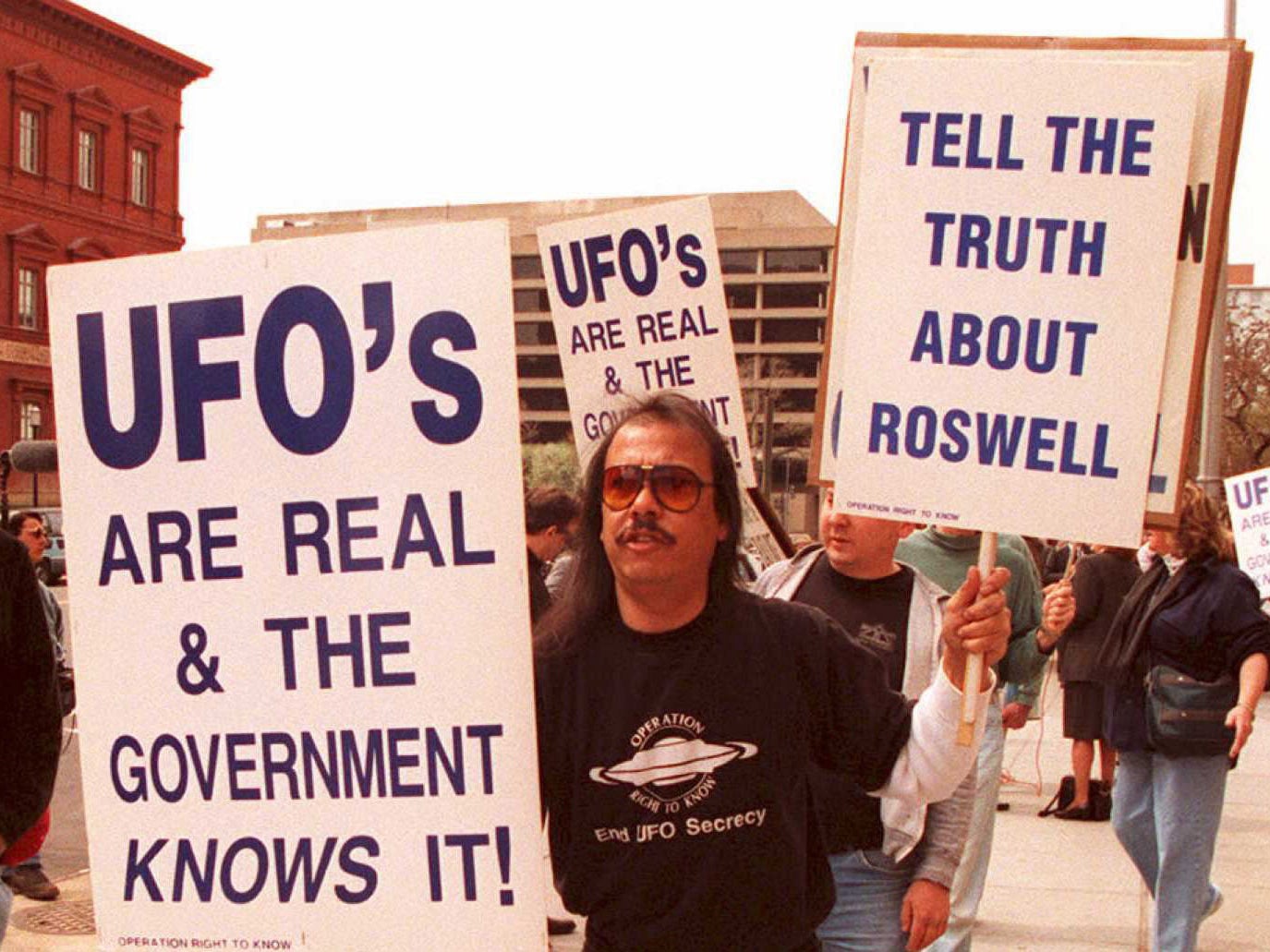UFOs, UAPs and ETs: Why some people believe aliens are visiting us right now
Those who fear or hope that aliens might be invading are not alone – at least in one sense


In 1947, scraps of rubber and metal found in Roswell, New Mexico arguably began the hunt for UFOs and alien life on our planet. That collection of debris was officially from a downed weather balloon – but that official explanation has not satisfied the many who claim that it was the remains of something not of this world.
Nearly 80 years later, a balloon has kicked off another round of fears and excitement about alien invasion. In recent days, the US military has shot down a run of unidentified objects – which followed the downing of what was said to be a Chinese weather balloon – and has given little explanation of what they are or what they might have been doing.
In the decades since those events in Roswell, the world has seen a growing interest in UFOs, and where they might have come from. And sceptics have long argued that rather than being any new technology – either of this Earth or another planet entirely – many of those sightings might indeed be weather balloons.
It is fitting, therefore, that the latest excitement has been prompted by what appear to be observation balloons of some kind, though that is still unconfirmed. And that official secrecy, too, is in keeping with the mystery that has surrounded those objects ever since that material fell to Earth in the New Mexico desert.
Humans have speculated for centuries about the possibility that the skies might be alive with something alien. Indeed, a whole conspiracy theory of its own – known as “ancient astronauts” – has pointed to what it claims are references in historic texts that describe unusual events in the sky.
But the modern excitement about UFOs really began in the middle of the 20th century. During the war, some pilots described seeing lights in the sky that became known as “foo fighters” and have still not been definitively explained.
Then followed Roswell, which helped kick off an excitement about UFOs that started soon after the debris was found in 1947 and continued throughout the 1950s and on to this day. Those sightings came at a time of tensions between the US and the Soviet Union, and many have speculated that the interest in the sightings could be at least a result of that anxiety.
In 2023, the world is in much the same state: for years, pilots have been reporting unusual flying objects in the sky, and – amid increasing global tensions – downed objects have led to theories about UFOs.
In recent years, officials have looked to avoid using the word “UFO” and instead refer to the objects as UAPs, or unidentified anomolous phenomenon. That is in part an attempt at making the word more accurate and neutral, but it has also come at a time of increased, serious interest in the objects.
In recent years, new reports have made clear that the US has been taking at least some reports of objects seriously. In 2017, videos were published that showed fighter jets encountering objects that appeared to be moving in ways that looked to be impossible with existing hardware.
Since then, more videos have been released and new reports have shown that the US had been conducting its own – largely secret – work to examine what those unidentified aerial phenomena might be. Reports also made public the existence of the Advanced Aerospace Threat Identification Program, a programme undertaken by the US government to investigate such events.
Amid those disclosures, US military and government officials have become increasingly open about the fact that there appears to be unknown things in the sky. Few have given any indication at all about what they might believe them to be, but possible explanations have included everything from aliens to secret military hardware.
Late last year, Nasa announced that it would be launching an independent study into UAPs. Over the course of nine months – ending this summer – a team will be analysing information from a range of sources in an aim to explain what they are.
“Exploring the unknown in space and the atmosphere is at the heart of who we are at NASA,” said Thomas Zurbuchen, associate administrator of the Science Mission Directorate at NASA Headquarters in Washington. “Understanding the data we have surrounding unidentified anomalous phenomena is critical to helping us draw scientific conclusions about what is happening in our skies. Data is the language of scientists and makes the unexplainable, explainable.”
The space agency noted that the work was important in part because it is tasked with ensuring that spacecraft remain safe. The data gathered through the study will be important in helping inform that work, it said.
Nasa’s announcement followed the publication, in 2021, of a report from the US Office of the Director of National Intelligence that summarised the public information about UAPs. It was launched in recognition of that new interest in the objects – as well as fears that they could be the result of some leap forward by a foreign military power.
That report looked at 144 observations of “unidentified aerial phenomena”, mostly collected from the US Navy between 2004 and 2021. It could only explain one of those sightings – which it said was a “deflating balloon”.
Weather and other observation balloons have long been mooted as an explanation for sightings of UAPs. They have a number of characteristics that make them good suspects: they can appear to move oddly, their shape and lack of details means that it can be hard to tell how large or far away they are, and there are a lot of them.
Each day, around 1800 of such balloons are launched across the world. And so officials and experts have suggested that the new surge in reports of weather balloons – and the new tensions between China and the US that have arisen from them – is not so much the result of there being more balloons but more people looking for them.
It might simply be that the sky has been filled with such UAPs, for years or even decades, without people taking much of an interest. As such, the new focus might mean that we become more aware of those objects – and that we will only learn more about what we do not know about them.
For now, officials have been coy about confirming anything about the unidentified objects: including whether they are alien or anything else. Historically, it has been that lack of information that has usually been filled with speculation about flying saucers and alien visits.
Join our commenting forum
Join thought-provoking conversations, follow other Independent readers and see their replies
Comments


Bookmark popover
Removed from bookmarks